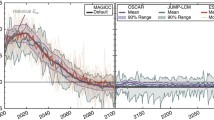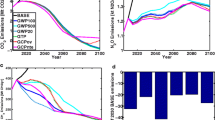Abstract
While most long-term mitigation scenario studies build on a broad portfolio of mitigation technologies, there is quite some uncertainty about the availability and reduction potential of these technologies. This study explores the impacts of technology limitations on greenhouse gas emission reductions using the integrated model IMAGE. It shows that the required short-term emission reductions to achieve long-term radiative forcing targets strongly depend on assumptions on the availability and potential of mitigation technologies. Limited availability of mitigation technologies which are relatively important in the long run implies that lower short-term emission levels are required. For instance, limited bio-energy availability reduces the optimal 2020 emission level by more than 4 GtCO2eq in order to compensate the reduced availability of negative emissions from bioenergy and carbon capture and storage (BECCS) in the long run. On the other hand, reduced mitigation potential of options that are used in 2020 can also lead to a higher optimal level for 2020 emissions. The results also show the critical role of BECCS for achieving low radiative forcing targets in IMAGE. Without these technologies achieving these targets become much more expensive or even infeasible.



Similar content being viewed by others
Notes
The model names are acronyms. IMAGE = Integrated Model to Assess the Global Environment; TIMER = The IMage Energy Regional model; FAIR-SiMCaP = Framework to Assess International Regimes for the differentiation of commitments - Simple Model for Climate Policy Assessment.
All prices and costs are expressed in 2005 US Dollars.
References
Azar C, Lindgren K, Obersteiner M et al (2010) The feasibility of low CO2 concentration targets and the role of bio-energy with carbon capture and storage (BECCS). Clim Change 100:195–202
Bouwman AF, Kram T, Klein Goldewijk K (2006) Integrated modelling of global environmental change. An overview of IMAGE 2.4. Netherlands Environmental Assessment Agency, Bilthoven
Clarke L, Edmonds J, Krey V et al (2009) International climate policy architectures: overview of the EMF 22 International Scenarios. Energy Econ 31 (SUPPL 2):S64–S81
den Elzen M, Meinshausen M, van Vuuren D (2007) Multi-gas emission envelopes to meet greenhouse gas concentration targets: costs versus certainty of limiting temperature increase. Glob Environ Change 17:260–280
Forster P, Ramaswamy V, Artaxo P et al (2007) Changes in atmospheric constituents and in radiative forcing. In: Solomon S, Qin D, Manning M, Chen Z, Marquis M, Averyt KB, Tignor M, Miller HL (eds) Climate change 2007: The Physical Science Basis. Contribution of Working Group I to the Fourth Assessment Report of the Intergovernmental Panel on Climate Change. Cambridge University Press, Cambridge
GEA (2012) Global energy assessment—toward a sustainable future. Cambridge University Press, Cambridge
Harnisch J, Klaus S, Wartmann S, Rhiemeier JM (2009) Development of F-gas module for TIMER model. ECOFYS, Nuremberg
IPCC (2007) In: Solomon S, Qin D, Manning M, Chen Z, Marquis M, Averyt KB, Tignor M, Miller HL (eds) Climate change 2007: The Physical Science Basis, Contribution of Working Group I to the Fourth Assessment Report of the Intergovernmental Panel on Climate Change. Cambridge University Press, Cambridge
Knopf B, Edenhofer O, Flachsland C et al (2010) Managing the low-carbon transition—From model results to policies. Energy J 31:223–245
Krey V, Riahi K (2009) Implications of delayed participation and technology failure for the feasibility, costs, and likelihood of staying below temperature targets-Greenhouse gas mitigation scenarios for the 21st century. Energy Econ 31:S94–S106
Kriegler E, Tavoni M, Aboumahboub T et al (in review) Can we still meet 2°C with global climate action? The LIMITS study on implications of Durban Action Platform scenarios. Clim Change Econ
Kriegler E, Weyant JP, Blanford GJ et al. (2013) The role of technology for achieving climate policy objectives: overview of the EMF 27 study on technology and climate policy strategies. Clim Change. doi:10.1007/s10584-013-0953-7
Lucas PL, van Vuuren DP, Olivier JGJ, den Elzen MGJ (2007) Long-term reduction potential of non-CO2 greenhouse gases. Environ Sci Policy 10:85–103
Meinshausen M, Raper SCB, Wigley TML (2011) Emulating coupled atmosphere–ocean and carbon cycle models with a simpler model, MAGICC6 - Part 1: model description and calibration. Atmos Chem Phys 11:1417–1456
O’Neill BC, Riahi K, Keppo I (2010) Mitigation implications of midcentury targets that preserve long-term climate policy options. Proc Natl Acad Sci U S A 107:1011–1016
OECD (2012) OECD environmental outlook to 2050. OECD, Paris
Pugh G, Clarke L, Marlay R et al (2011) Energy R&D portfolio analysis based on climate change mitigation. Energy Econ 33:634–643
Riahi K, Kriegler E, Johnson N et al (2013) Locked into Copenhagen Pledges—Implications of short-term emission targets for the cost and feasibility of long-term climate goals. Technological Forecasting and Social Change (in press)
Rogelj J, Hare W, Lowe J et al (2011) Emission pathways consistent with a 2°C global temperature limit. Nature Clim Change 1:413–418
Rogelj J, McCollum DL, O’Neill BC, Riahi K (2013) 2020 emissions levels required to limit warming to below 2°C. Nature Clim Change 3:405–412
UNEP (2012) The emissions gap report 2012. A UNEP Synthesis Report, UNEP
UNFCCC (2011) Report of the Conference of the Parties on its seventeenth session, held in Durban from 28 November to 11 December 2011. Addendum. Part two: Action taken by the Conference of the Parties at its seventeenth session. Decision 2/CP.17: outcome of the work of the Ad Hoc Working Group on Long-term Cooperative Action under the Convention. FCCC/CP/2011/9/Add.1
van Vliet J, den Elzen MGJ, van Vuuren DP (2009) Meeting radiative forcing targets under delayed participation. Energy Econ 31:S152–S162
van Vliet J, van den Berg M, Schaeffer M et al (2012) Copenhagen Accord Pledges imply higher costs for staying below 2°C warming—A letter. Clim Change 113:551–561
van Vuuren DP (2007) Energy systems and climate change. Scenarios for an Uncertain Future, Science, Technology and Society., Utrecht University, Utrecht
van Vuuren DP, Den Elzen MGJ, Lucas PL et al (2007) Stabilizing greenhouse gas concentrations at low levels: an assessment of reduction strategies and costs. Clim Change 81:119–159
van Vuuren DP, Kok MTJ, Girod B, Lucas PL, de Vries B (2012) Scenarios in Global Environmental Assessments: key characteristics and lessons for future use. Glob Environ Change 22:884–895
van Vuuren DP, Riahi K (2011) The relationship between short-term emissions and long-term concentration targets. Clim Change 104:793–801
van Vuuren DP, Deetman S, van Vliet J et al (2013) The role of negative CO2 emissions for reaching 2 °C-insights from integrated assessment modeling. Clim Change 118:15–27
Velders GJM, Fahey DW, Daniel JS, McFarland M, Andersen SO (2009) The large contribution of projected HFC emissions to future climate forcing. Proc Natl Acad Sci U S A 106:10949–10954
Author information
Authors and Affiliations
Corresponding author
Additional information
This article is part of the Special Issue on “The EMF27 Study on Global Technology and Climate Policy Strategies” edited by John Weyant, Elmar Kriegler, Geoffrey Blanford, Volker Krey, Jae Edmonds, Keywan Riahi, Richard Richels, and Massimo Tavoni.
Electronic supplementary material
Below is the link to the electronic supplementary material.
ESM 1
(DOCX 30.1 KB)
Rights and permissions
About this article
Cite this article
van Vliet, J., Hof, A.F., Mendoza Beltran, A. et al. The impact of technology availability on the timing and costs of emission reductions for achieving long-term climate targets. Climatic Change 123, 559–569 (2014). https://doi.org/10.1007/s10584-013-0961-7
Received:
Accepted:
Published:
Issue Date:
DOI: https://doi.org/10.1007/s10584-013-0961-7




